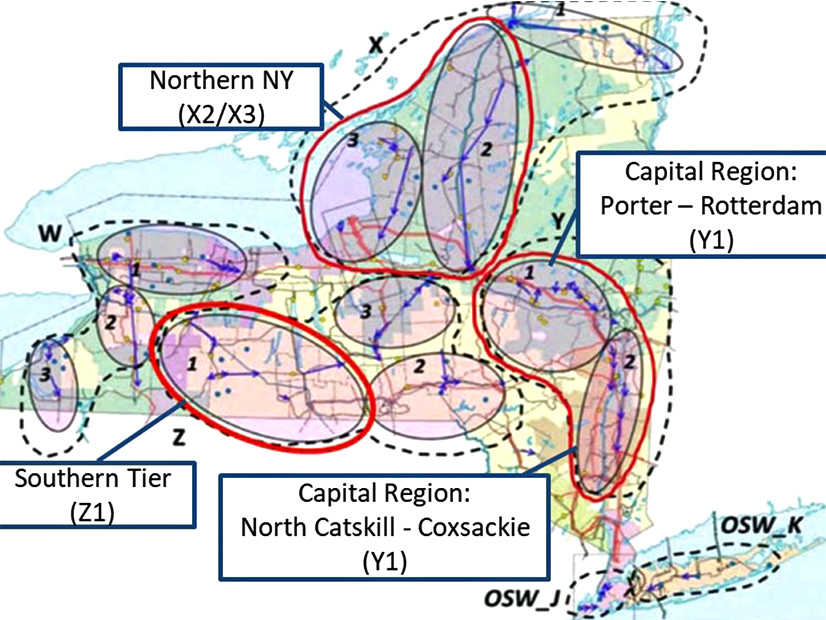
The New York Public Service Commission on Thursday approved 62 transmission upgrades with a combined capacity of 3.5 GW and an estimated cost of $4.4 billion.
The projects in three upstate regions are needed to loosen existing constraints in preparation for the state’s transition from fossil fuel-generated electricity to substantially larger amounts of clean renewable energy, according to the commission.
The price tag is only an estimate, and the final cost could range anywhere from $3.3 billion to $6.6 billion, which is a standard range of uncertainty for such projects, said Elizabeth Grisaru, deputy director of the Department of Public Service’s Office of Electric, Gas & Water.
The resulting monthly increase in customers’ bills could range from 3% to 16%, though success with the projects would prevent curtailment risk charges being passed from generators to utilities to ratepayers, she said.
The large price tag — and the fact that it is only one of many costs to be borne by ratepayers through the clean energy transition — gave some commissioners pause, but the majority voted for it.
The 62 upgrades are planned by Central Hudson Gas & Electric, National Grid, New York State Electric & Gas and Rochester Gas and Electric. The projects are focused in three areas of concern: the Hudson Valley and Mohawk Valley, extending south and west from Albany; the North Country, from the western Adirondacks to Lake Ontario and the Canadian border; and the Southern Tier, along the Pennsylvania border.
The utilities said there is 689 MW of existing solar and wind generation in these areas and 3,529 MW in some stage of development.
The work will be completed through the coming decade. Costs will be allocated across ratepayers statewide, as the benefits of decarbonization will extend to all New Yorkers.
Grisaru told commissioners that the projects were a result of the state’s Climate Leadership and Community Protection Act (CLCPA), the landmark 2019 law that codified decarbonization goals including 70% renewable energy by 2030. The concurrent transition to electric vehicles and all-electric buildings will create added power demand statewide.
Passage of the Accelerated Renewable Energy Growth and Community Benefit Act led the PSC in May 2020 to start a proceeding to plan the transmission infrastructure needed to accommodate these changes.
The three upstate regions were identified as problem zones in September 2021, and the utilities were directed to submit plans for upgrades.
Grisaru said the 62 projects are a snapshot estimate by the utilities, circa late 2021, of their future needs, but more generation projects have gone into development since then, and further transmission upgrades may be needed. Based on this, the package of 62 upgrades is a very conservative response to present and potential future needs, she said, with little risk of over-construction.
“I’m happy to see this project before us today,” PSC Chairman Rory Christian said. “We understand that to successfully decarbonize, we need to have a robust transmission system, and I’m encouraged that these investments will not only help us achieve that goal but help secure New York’s role as a leader in clean energy going forward.”
NYISO has highlighted the need for grid upgrades, and it did so again after Thursday’s vote.
“As stated in the NYISO’s 2021-2040 System & Resource Outlook, significant investments in generation and transmission projects are needed now to maintain the reliability and resiliency of our grid moving forward,” ISO spokesperson Kevin Lanahan said via email. “We’ll continue to work closely with elected officials, regulators and stakeholders to keep the grid working for all New Yorkers.”
The order was approved 5-2, with Commissioners Diane Burman and John Howard opposed. Both agreed with transmission expansion, but not with the mechanism by which the cost is being reviewed and allocated. They thanked Grisaru and her staff, however, for noting the uncertain cost of the upgrades.
Commissioner John Maggiore wished the state’s progressive income tax could cover some of the cost, rather than all of it falling on ratepayers.
Commissioner James Alesi recalled the great delays and cost overruns with the Second Avenue Subway project in Manhattan and said he worried about the unknown future costs of CLCPA rollout, which is currently being estimated at $275 billion — about $14,000 per person, or $37,000 per household statewide.
The PSC has divided transmission upgrades that have been proposed to accommodate expanded renewable energy in the wake of CLCPA into two categories: Phase 1, which also incorporates safety and reliability considerations, and Phase 2, which solely to supports new resources. Thursday’s order was the first Phase 2 approval by the PSC.


